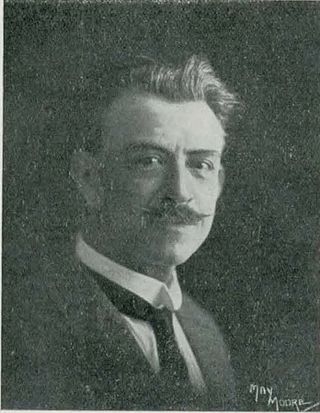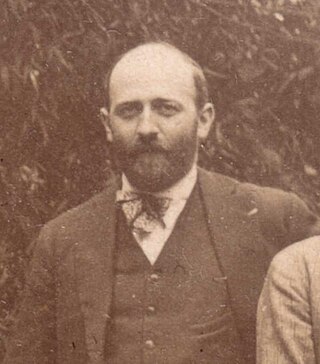Related Research Articles

Alfred Francis Hill CMG OBE was an Australian-New Zealand composer, conductor and teacher.

Alexis Fernand Félix Jean Rivier was a French composer of classical music in the neoclassical style.
Frédéric Devreese was a Belgian composer of mostly orchestral, chamber and piano works that have been performed throughout the world; he was also active as a conductor. Devreese is known for his film scores, including Benvenuta by André Delvaux and The Cruel Embrace by Marion Hänsel.
Introduction and Allegro for Harp, Flute, Clarinet and String Quartet is a chamber work by Maurice Ravel. It is a short piece, typically lasting between ten and eleven minutes in performance. It was commissioned in 1905 by the Érard harp manufacturers to showcase their instruments, and has been described as a miniature harp concerto. The premiere was in Paris on 22 February 1907.
Edvard Grieg's String Quartet No. 1 in G minor, Op. 27, is the second of three string quartets written by the composer. The first, in D minor, was an early work, now lost, written in the early 1860s at the request of his teacher, Carl Reinecke. The third quartet, in F major, remained incomplete at the composer's death.
The Quartettsatz in c-Moll, D. 103 was composed by Franz Schubert in 1814. It is believed to be the only surviving movement of a complete quartet in C minor.
The String Quartet No. 1 in mixed keys was composed by Franz Schubert in 1810 or 1811.
String Quartet No. 1 in B-flat major "Maori Quartet", Stiles 1.2.3.3 SQ1 is the first of Alfred Hill's seventeen string quartets. Its composition began before 1892, it was completed after 1896 and premiered only on 18 May 1911 in Sydney.
Alfred Hill composed his String Quartet No. 3 in A minor "The Carnival", Stiles 1.2.3.3 SQ3, in 1912, while he was a member of the Austral String Quartet. The manuscript score is preserved in the National Library of Australia. In 1955, Hill transformed the quartet into his Symphony No. 5. The quartet is composed in four movements with an average duration of 20 minutes.
String Quartet No. 2 in G minor "A Maori Legend in Four Scenes", Stiles 1.2.3.3 SQ2, often called "Maori Quartet", was composed by Alfred Hill in 1907–1911 and premiered immediately in 1911. It is dedicated to Earnest [sic] Wunderlich — "in slight appreciation". The first two quartets were published together by Breitkopf & Härtel in 1913. Each of them used to be referred as Maori, a feature that can lead to confusion. Today the first one is called Maori, while for the second the longer subtitle is retained.
Symphony No. 1 in B-flat major, Stiles 1.3.4.1 Sy1, the so-called Maori Symphony, is the first symphony by Alfred Hill. Its first three movements were completed by 1898, but the last movement remained unfinished. This may have been the second symphony composed in the Antipodes. The first two movements of this symphony are the only symphonic movements by Hill not to be arranged from his earlier chamber music. The Finale was reconstructed by Allan Stiles, and the whole symphony got its first performance in 2007. The approximate duration is 40 minutes.
Violin Sonata No. 4 in C minor "Maori Sonata", Stiles 1.2.1.6 So4, is a sonata for violin and piano by Alfred Hill composed ca.1909. It was premiered on 6 April 1910 by Cyril Monk and Laurence Godfrey Smith in the YMCA Hall, Sydney. Its approximate duration is 18 minutes.
Violin Sonata No. 2 in A minor, Stiles 1.2.1.6 So2, is a sonata for violin and piano by Alfred Hill completed at the beginning of 1906. Its manuscript is at the National Library of Australia. It bears inscription: Island Bay Wellington N.Z. 10th January 1906. The sonata is dedicated to an Australian violinist Cyril Monk, Hill's pupil in theory and composition. Its approximate duration is 16 minutes.
String Quartet No. 4 in C minor, Stiles 1.2.3.3 SQ4, was completed by Alfred Hill on 25 July 1916 in Neutral Bay, Sydney. It is dedicated to Henri Verbrugghen and his Verbrugghen String Quartet. It is Hill's first non-program string quartet. The first two movements were transcribed for orchestra in 1955 forming the basis of the Symphony No. 4 "The Pursuit of Happiness" in which this music turns to have a program.
Symphony No. 4 in C minor "The Pursuit of Happiness", Stiles 1.3.4.1 SyP, was finished by Alfred Hill in 1954 or 1955. Its first two movements were arranged from Hill's String Quartet No. 4 (1916), while the last one derives from the finale of his String Quartet No. 17. The symphony is dedicated "to my esteemed friend Henry Kripps", a prominent Australian conductor. Its approximate duration is 20 minutes.
The Piano Concerto No. 5 in D major, Op. 120 "Concerto Pastorale", by Ferdinand Ries was composed between 1813-1816 and published in 1823 by the firm of Sauer & Leidesdorf with a dedication to Prince Oscar of Sweden.
String Quartet No. 5 in E-flat major "The Allies", Stiles 1.2.3.3 SQ5, was completed by Alfred Hill on 24 June 1920 in Sydney. It is dedicated to Henri Verbrugghen, whose quartet gave the first public performance of the composition on 2 March 1921. The music of the quartet presents four nations who were allies during World War I. It was subsequently arranged by Hill for string orchestra as his Symphony No. 11 "The Four Nations". The approximate duration of the quartet is 29–33 minutes, which makes it one of the most substantial quartets composed by Hill.
Symphony No. 11 in E-flat major "The Four Nations" for string orchestra, Stiles 1.3.3.1 SyFN, was arranged by Australian composer Alfred Hill from his String Quartet No. 5 "The Allies" at some point in 1950s, but the precise date remains unknown, and there is no information about the first performance. The music of the symphony follows that of the original String Quartet, except for the Finale being 4 bars shorter than in the quartet, due to a minor truncation of the melody of the main subject at each repeat of it. The most obvious difference is the addition of the double bass part. Hill also altered the title of the composition.
String Quartet No. 7 in A major, Stiles 1.2.3.3 SQ7, by Australian composer Alfred Hill was commenced in Melbourne and finished in Sydney on 18 November 1934, as stated in the manuscript score preserved in the National Library of Australia. It is thought to be the last of Hill's middle period quartets, with some impressionistic features being transitional to his later compositions. Approximate duration is 20,5 minutes.
String Quartet No. 8 in A major, Stiles 1.2.3.3 SQ8, by Australian composer Alfred Hill was finished half month after his Seventh: the manuscript score and parts, which are preserved in the National Library of Australia, are dated 6 December 1934. While the previous quartet was a somewhat transitive composition from his middle period, with the Eighths one starts counting Hill's late quartets. It is thematically unified and has many impressionistic features. In 1950s Hill arranged it into a string symphony, the first known performance of which was on 27 March 1957. The approximate duration of the quartet is 25–28 minutes.
References
- ↑ Allan Stiles. A Catalogue of the Music of Alfred Hill
- ↑ Alfred Hill's second wife, Mirrie Hill, in a 1971 interview mentions "the boys" coming round for quartet practice (Melissa Rogers. Revisiting Alfred Hill (1869–1960): Examining issues of reception and compositional approach , PhD thesis. Sydney: UNSW, 2018)
- ↑ Library catalogue entry for the manuscript score and parts
- ↑ Donald Maurice. Booklet notes to Naxos 8.572097
- ↑ Stiles Music Publications